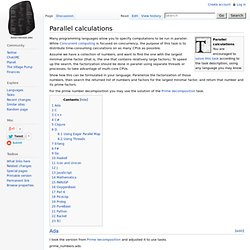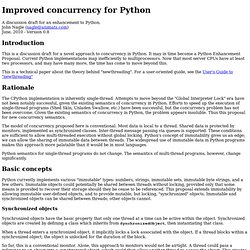

Parallel Programming related Projects ith Python Interfacing. Multiprocessing. Parallel calculations. Parallel calculations You are encouraged to solve this task according to the task description, using any language you may know.

Many programming languages allow you to specify computations to be run in parallel. While Concurrent computing is focused on concurrency, the purpose of this task is to distribute time-consuming calculations on as many CPUs as possible. Assume we have a collection of numbers, and want to find the one with the largest minimal prime factor (that is, the one that contains relatively large factors). To speed up the search, the factorization should be done in parallel using separate threads or processes, to take advantage of multi-core CPUs. Show how this can be formulated in your language. For the prime number decomposition you may use the solution of the Prime decomposition task. [edit] Ada I took the version from Prime decomposition and adjusted it to use tasks. prime_numbers.ads: prime_numbers.adb: Example usage: parallel.adb: Output: [edit] C C code using OpenMP.
[edit] D. Improved concurrency for Python. A discussion draft for an enhancement to Python.

John Nagle (nagle@animats.com) June, 2010 - Version 0.8 Introduction This is a discussion draft for a novel approach to concurrency in Python. It may in time become a Python Enhancement Proposal. Current Python implementations map inefficiently to multiprocessors. This is a technical paper about the theory behind "newthreading". Rationale The CPython implementation is inherently single-thread. The model of concurrency proposed here is conventional. Python semantics for single-thread programs do not change. Basic concepts Python currently implements various "immutable" types: numbers, strings, immutable sets, immutable byte strings, and a few others. Synchronized objects Synchronized objects have the basic property that only one thread at a time can be active within the object. When a thread enters a synchronized object, it implicitly locks a lock associated with the object.
So far, this is a conventional monitor. Atomic objects "Freezing" Eval. Multithreading - Can't pickle <type 'instancemethod'> when using python's multiprocessing Pool.map() Python 3 Patterns, Recipes and Idioms: An Open-Source Book. ParallelProcessing. A number of Python-related libraries exist for the programming of solutions either employing multiple CPUs or multicore CPUs in a symmetric multiprocessing (SMP) or shared memory environment, or potentially huge numbers of computers in a cluster or grid environment.

This page seeks to provide references to the different libraries and solutions available. Symmetric Multiprocessing Some libraries, often to preserve some similarity with more familiar concurrency models (such as Python's threading API), employ parallel processing techniques which limit their relevance to SMP-based hardware, mostly due to the usage of process creation functions such as the UNIX fork system call. However, a technique called process migration may permit such libraries to be useful in certain kinds of computational clusters as well, notably single-system image cluster solutions (Kerrighed, OpenSSI, OpenMosix being examples). Cluster Computing Cloud Computing Google App Engine - supports Python. Grid Computing.